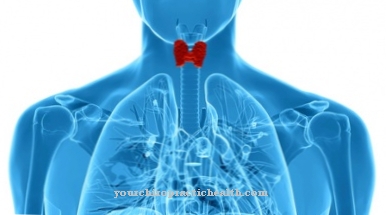The ability to move antagonistic muscles in rapid succession is known as diadochkinesis. Disorders of this type of movement are summarized under the term dysdiadochkinesis and are usually the result of a cerebellar lesion. Treatment of the Dysdiadochkinesis limited to physical therapy training.
What is dysdiadochokinesis?

© Racle Fotodesign - stock.adobe.com
Humans have the ability to repeatedly perform movements in rapid succession, such as those required for turning the forearm in and out in the sense of pronation and supination and for processes such as changing light bulbs. This ability is called diadochkinesis. If this ability is impaired, the doctor speaks of dysdiadochkinesis.
If there is only a slowdown in movements, it is called bradydiadochokinesis. Dysdiadochkinesis differs from this in that there are limitations beyond speed. This is to be distinguished from adiadochokinesis, which makes it completely impossible for the affected person to coordinate the described movement sequences.
Dysdiadochkinesis is an ataxia and at the same time the symptom of a brain lesion in the regions of fine motor control. The dysdiadochkinesis does not have to be recognizable at first sight, but it is a serious symptom that affects those affected severely in everyday life.
causes
The ability to move in rapid succession in the sense of Diadochkinesis depends on a person's fine motor skills. The fine motor skills are controlled primarily in the brain regions of the cerebellum. Exercise programs are designed in the cerebellum. The human being can also control the processes during the execution of the movement, since various feedbacks are provided by the kinaesthetic analyzer.
Subcortical and supraspinal control centers are involved in this control on an unconscious level. The finest coordination is implemented by spinal centers and supraspinal regions of the brain stem. Together with the motor cortex, these centers enable safe movements in spite of any disturbance variables.
Dysdiadochkinesis can occur when a fine motor region of the brain suffers from lesions or spinal lesions impair fine motor skills. Most often, the phenomenon is due to primary causes such as strokes, Parkinson's disease, and cerebellar diseases such as lesions in multiple sclerosis.
Patients with dysdiadochkinesis can no longer carry out rapid successions of antagonistic movements such as pronation and supination in a coordinated and orderly manner. The symptom can manifest itself in both the upper and lower limbs. A manifestation on the lower limbs results in impairment in walking.
Antagonistic movement sequences are all movements that are based on the activation of a certain muscle and the activation of its antagonist immediately afterwards. The antagonist of a muscle is its direct opponent. The antagonists of the flexor muscles are, for example, the extensor muscles. In most cases the muscle strength of patients with dysdiadochkinesis is intact. So you are not affected by paresis, but by ataxia.
If there is a gait ataxia in addition to diadochkinesis, this symptom manifests itself in an unsteady gait with legs apart. In addition, atactic damage to the brain sometimes leads to movements of the wrong magnitude, such as excessive types of movement. Dysdiadochokinesis can also be associated with unnecessary, shaky movements. The individual accompanying symptoms depend on the primary cause of the dysdiadochokinesis.
Diseases with this symptom
- Ataxia
- Parkinson's
- multiple sclerosis
- Ligament strain
- limp
- Muscle strain
Diagnosis & course of disease
A neurological examination is used to diagnose dysdiadochokinesis. As part of this examination, for example, patients are asked to perform the movements with their hands that are required to screw in a lightbulb. If the sequence of movements seems uncoordinated, there is dysdiadochokinesis.
Since dysdiadochokinesis is only a symptom of a central nervous lesion, the primary cause of the atactic disorder must also be determined as part of the diagnosis. As a rule, the doctor uses imaging methods such as MRI for this purpose, which can depict the brain as well as the spine and its tissue.
In many cases, the diagnosis of a central nervous lesion precedes the diagnosis of dysdiadochokinesis. The prognosis for patients with dysdiadochokinesis depends on the primary cause of the disorder.
Complications
Dysdiadochokinesis can lead to coordination disorders, restricted mobility and other complications. Muscle tension in the wrist often occurs, and depending on the severity of the disease, severe ligament strains or even fractures. The complications are triggered by turning the hand quickly, which can also lead to pain and circulatory disorders in the affected limb. In the cerebellum, where the disease originated, further damage to the nerve cells can occur in the course of the disease, accompanied by various symptoms of the central nervous system.
Those affected, mostly stroke patients, sometimes also suffer from severely restricted mobility, which can lead to further diseases of the musculoskeletal system and, under certain circumstances, the nervous system. With the treatment itself, complications are unlikely: Dysdiadochokinesis is mainly treated by physiotherapy, which can only trigger further symptoms in the case of severe damage to the nerves. Pain is often the biggest problem for those affected, as it occurs suddenly in severe episodes and reduces the quality of life.
Painkillers should be carefully selected because of the sensitive symptoms and taken under the supervision of a doctor, as the already damaged nervous system is sensitive to various preparations. Incorrect treatment as a result of an incorrect diagnosis can also lead to complications, as it only treats the symptoms but not the causes of the disease.
When should you go to the doctor?
Dysdiadochokinesis is a movement coordination disorder. It is the opposite of diadochokinesis, in which there is no problem in performing opposite movements in quick succession. However, if there is dysdiadochokinesis, this only works irregularly or not at all. Dysdiadochokinesis is almost always based on damage to the cerebellum.
Sometimes it can also be caused by a functional impairment of the spinal cord or peripheral nerves. This damage, in turn, is often caused by a disease: in addition to direct diseases of the cerebellum, strokes, Parkinson's syndrome and multiple sclerosis are particularly possible.
After a preliminary discussion with the family doctor, he will probably refer his patients to a neurologist for further medical treatment. The regression of dysdiadochokinesis is not to be expected. The patients mainly benefit from physiotherapy in order to regain at least part of their quality of life. It is also important to avoid consequential damage.
The lack of mobility triggered by dysdiadochokinesis repeatedly leads to muscle tension in the wrist or even to ligament strains and fractures as well as severe pain. Pain therapy with medication poses a particular challenge because the nervous system that is already impaired reacts extremely sensitively to pain medication. In the case of dysdiadochokinesis, only symptom relief is usually possible, but no healing of the cause.
Doctors & therapists in your area
Treatment & Therapy
In most cases, dysdiadochokinesis cannot be treated causally, only symptomatically. Lesions in the brain and spinal nerve tissue do not actually heal. The nerve tissue in the central nervous system is only able to regenerate to a very limited extent. That being said, even healed lesions always leave scars in the tissue.
The nerve cells at the site of the scar are unusable and no longer have any function. As a result, injuries to the central nervous system are often associated with irreversible damage and loss of function. However, studies on stroke patients have shown that neighboring nerve cells are able to take over the functions of the damaged nerve cells.
The central nervous system always feels motivated to take over this function when the lost functions often seem to be needed. For example, a patient with dysdiadochokinesis can specifically train the sequence of antagonistic muscle movements under physiotherapeutic care.
In addition, the central nervous system is to be motivated to relocate the functions from the damaged areas and to pass them on to intact nerve cells. In this way, dysdiadochokinesis can be curable even if its actual cause cannot be completely eliminated.
Outlook & forecast
As a rule, dysdiadochokinesis leads to severe impairment of mobility and coordination. The person affected can often no longer move or find their way around on their own and is dependent on the help of other people. Walking aids are required if mobility is very limited.
To outsiders, the quick movements or twisting of the hands can seem bizarre. This leads to bullying or teasing, especially in children, and can cause serious mental illness as a result. In many cases, the patients also suffer from severe pain, which reduces the quality of life.
Dysdiadochokinesis is often treated with pain therapy and physiotherapy. Whether or not these therapies are successful depends heavily on the cause of the dysdiadochokinesis. A complete cure is not always possible in patients who have suffered a stroke. However, the muscles can be trained and thus learn their normal movement again.
In order to prevent dysdiadochokinesis, a stroke in particular should be prevented. A healthy lifestyle with plenty of exercise and a healthy diet is ideal for this.
prevention
Dysdiadochokinesis can only be prevented to the extent that lesions of nerve tissue in the cerebellum can be prevented. Since such a lesion can occur as a result of a stroke, for example, the preventive measures for a stroke can in the broadest sense also be understood as preventive steps in relation to dysdiadochokinesis.
You can do that yourself
The methods of self-help are very limited in dysdiadochokinesis. In general, a healthy lifestyle has a very positive effect on the symptom. This not only includes a healthy diet, but also regular exercise. This lifestyle can also prevent dysdiadochokinesis as it greatly reduces the risk of stroke.
However, it is not possible to completely eliminate the symptoms of dysdiadochokinesis. Physiotherapy is necessary in many cases. However, the associated exercises can also be performed at home. In some cases, this requires the help of friends, relatives or that of your partner. The more the patient exercises, the higher the chances that intact nerve cells will be displaced and that normal movement sequences will be possible again. Above all, certain movements of the muscles should be trained in a targeted manner. This seems relatively difficult for the person concerned at first, but can quickly lead to success.
However, the patient should also have a strong will. Because not to be despised is the mental support during training. If the movements are painful, pain relievers or cooling ointments can be used. In the long term, however, the pain relievers should not be used.

























.jpg)


